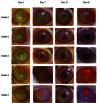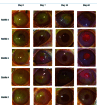Risk of Induction of Corneal Neovascularization with Topical Erythropoietin: An Animal Safety Study
- PMID: 38737499
- PMCID: PMC11082528
- DOI: 10.18502/jovr.v18i3.13772
Risk of Induction of Corneal Neovascularization with Topical Erythropoietin: An Animal Safety Study
Abstract
Purpose: To evaluate the pro-angiogenic effect of topical erythropoietin on cornea in chemical burn-injured rabbit eyes.
Methods: The corneal alkali-burn injury was induced in 10 eyes of 10 rabbits using filter paper saturated with 1.0 mol sodium hydroxide. The eyes were categorized into the treatment group (n = 5) that received topical erythropoietin (3000 IU/mL) every 8 hr for one month versus the control group (n = 5) that received normal saline every 8 hr for one month. All eyes were treated with topical ciprofloxacin every 8 hr until corneal re-epithelialization was complete. Corneal epithelial defects, stromal opacity, and neovascularization were evaluated after the injury. At the conclusion of the study, the rabbits were euthanized and their corneas were submitted to histopathological examination.
Results: Baseline characteristics including the rabbits' weight and the severity of corneal injury were comparable in two groups. Time to complete corneal re-epithelialization was 37 days in the treatment group and 45 days in the control group (P = 0.83). There was no significant difference between the groups in the rate of epithelial healing or corneal opacification. Clinical and microscopic corneal neovascularization was observed in one eye (20%) in the treatment group and two eyes (40%) in the control group (P = 0.49).
Conclusion: Recombinant human erythropoietin administered topically did not induce vessel formation in rabbit corneas after chemical burn.
Keywords: Corneal Neovascularization; Rabbit Cornea; Topical Erythropoietin; Chemical Burns.
Copyright © 2023 Feizi et al.
Conflict of interest statement
The authors declared no potential conflicts of interest with respect to the research, authorship, and/or publication of this article.
Figures




References
-
- Grasso G, Sfacteria A, Cerami A, Brines M. Erythropoietin as a tissue-protective cytokine in brain injury: What do we know and where do we go? Neuroscientist 2004;10:93–98. - PubMed
-
- Heeschen C, Aicher A, Lehmann R, Fichtlscherer S, Vasa M, Urbich C, et al. Erythropoietin is a potent physiologic stimulus for endothelial progenitor cell mobilization. Blood. 2003;102:1340–1346. - PubMed
-
- Lund A, Lundby C, Olsen NV. High-dose erythropoietin for tissue protection. Eur J Clin Invest. 2014;44:1230–1238. - PubMed
LinkOut - more resources
Full Text Sources

